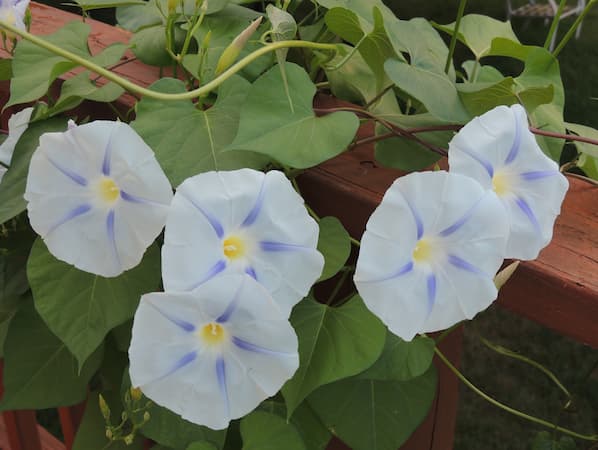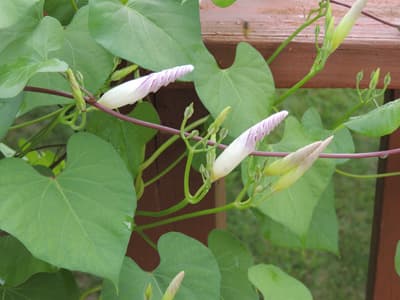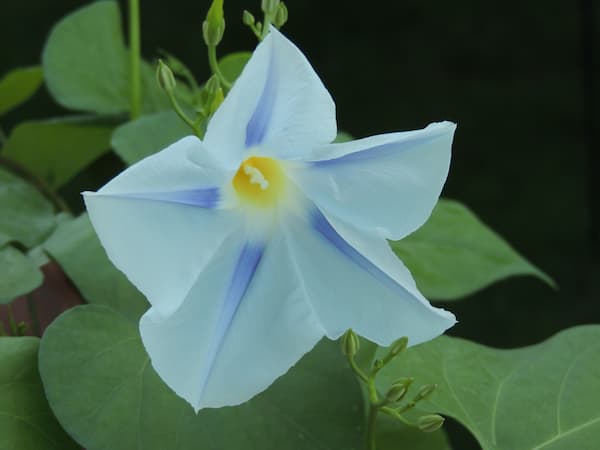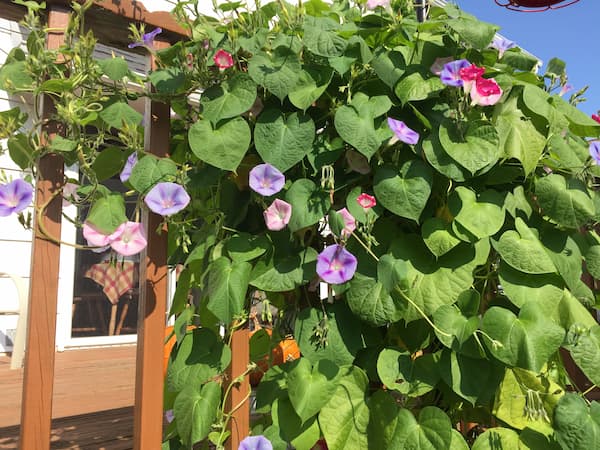How to Grow Morning Glory Flower Vine

About Growing Morning Glory Vine Flower Plants in Your Home Garden
Morning glory vine plants are speedy climbers. And, they are the ultimate in old-fashioned charm! Depending upon variety, the vines grow up to 20 feet in a season. The plants have dark, heart-shaped leaves and produce breath-taking trumpet flowers up to 3 inches in diameter. This “How to Grow Morning Glory Flower Guide Will helps you to grow these beautiful and prolific bloomers.
The big, fragrant flowers unfurl to greet the morning sun, then close up in the afternoon. Colors include white, red, pink, purple, blue, and many bicolors. Give this vining plant something tall to climb up. They will entwine themselves around any obstacles in their path. These flowers grow and look their best when they have something to climb. They are perfect grown on a fence, lamp post, or trellis.
Did you know? The Morning Glory family includes Moonflowers that only bloom at night.
Also see: More about Morning Glory varieties
Today’s Quote: “A morning glory at my window satisfies me more than the metaphysics of books.” – – Walt Whitman
Morning Glory Plant Specifications
Flower Colors: Blue, pink, purple and white. There are many bicolors.
Flowers Bloom: Summer through Fall.
Plant Height: Depending upon variety, the plants grow 18– 20 feet tall in a single season.
Ideal Soil pH: 6.0 – 7.5.
Light Requirement: Full sun.
Hardiness Zones: 2 – 11
Are Plants Toxic? Yes.
Deer Resistant? No
Native To: Tropical and sub-tropical North America and South America.
Plant Type: Annuals and a few perennials.
Botanical Name: Ipomea purpurea
Popular Varieties: Clark’s Heavenly Blue, Choice Picotee(blue and red), Grandpa Ott, Blues Brothers, Flying Saucers, Early Call.

Are Morning Glory Plants Edible?
NO!!
All parts of these plants are highly poisonous. They are toxic to humans, pets and other animals. Consumption may cause serious health issues.
The plants are poisonous if ingested. But, it is not harmful to touch them.
Keep this plant away from small children and pets.
Medicinal Uses for Morning Glory Plants
Despite being a toxic plant, Morning Glories have a variety of medicinal applications. Depending upon variety, here are some of the potential benefits:
- It is used as a laxative.
- Use it as a topical
- treatment for skin disorders.
- Moonflowers can ease digestive problems.
- It is used as an antispasmodic.
- Use it to treat anxiety.
- It treats insomnia.
Important Note: Because this is a toxic plant, you should not use it to make home remedies unless you are properly trained to do so.
Light Requirements
Grow Morning Glory plants in bright, direct, full sun. Select a planting location where they will receive six to eight housers of full sunlight.
The plants grow in partial sunlight. However, if they do not receive sufficient sunlight, the vine may not grow to its full potential. And, the vine may produce fewer blooms.
Morning Glory Plant Propagation
Morning Glory is grown from seeds. The seed coat is thick. Nick the seeds or soak them in warm water for a couple of hours, to soften them. This will increase germination rates and speed the time to germinate the seeds.
Sow the seeds early in the season, and cover lightly with 1/4″ of soil. Water thoroughly once. Thin or space plants to a final distance of 6″ apart. They will tolerate a little crowding if there are ample supports for their vines to spread up and out.
Tip: Seeds have a very hard coat. Nick seeds. or soak overnight to improve the germination rate.
Days to Germination: 5 – 10 days.

How to Grow Morning Glory Flower Plants
Growing Morning Glories is easy. The plants grow best in full sun. Add a general-purpose fertilizer when planting them, then once a month after that.
When the plants are young, you may want to train the vines to go up a trellis or post. Once they catch onto an item to climb, they need no further training.
Once your plants are established, they should grow well, even if left unattended. Soil should be moist, but not wet. Water them during dry periods, once or twice per week. Mulch around them to keep weeds down and improve appearance.
Morning Glories are half-hardy annuals. They will often survive the first frost, especially if grown along with the house or other buildings. They will not survive a hard frost or freeze.
For perennial varieties, cut the plant back close to the ground after they have gone dormant in the Fall.

How to Grow Morning Glories in Containers
Morning Glories are not often grown in containers or flowerpots. However, some people choose to grow them with great success in a container. They train them to grow across the railing of a balcony. The vines also look good spilling down from the balcony.
Like any container-grown plant, they need a little more care and attention. In addition to normal plant care, here’s how to grow Morning Glory vines in containers:
- It is important to have a drain hole to allow excess water to drain from the pot.
- Keep an eye on the moisture level. Check the plants every day or two, especially in extended periods of hot, dry weather.
- Keep the soil moist, but not wet. It is okay to let the top of the soil begin to dry between watering.
- When watering the plants, thoroughly wet the soil. Excess water will drain through the hole in the bottom of the flowerpot.
- Nutrients in a flowerpot are limited. So, use fertilizer spikes to feed the plants. Or, apply a light solution of liquid fertilizer once a month.
- Select a sunny to partly sunny location on your deck.
Pruning Morning Glory Plants
Morning Glory vines are basically a no maintenance plant.
Do not prune the plants. And, especially do not snip off the growing tips. Just “Let ’em grow”.
For a tidy appearance, remove the occasional dead or damaged leaves. You do not need to deadhead spent blooms. However, you can do so to improve to improve the appearance of the plant.
Insects and Plant Disease
The plants experience very few problems with insects and disease. If insect or disease problems occur, treat early with organic or chemical insect repellents and fungicide.
Also see: Plant Problems – Identify the causes and find the cures.
Related Articles
Also, people who read this article will like:
How to Grow Morning Glory Flower Plants – by Garden Hobbies
Please support our site. Shop for:
- rmmatthews100@hotmail.com
- 585-721-6528
- Rochester, NY
©1999-2024 GardenersNet.Com, All Rights Reserved

